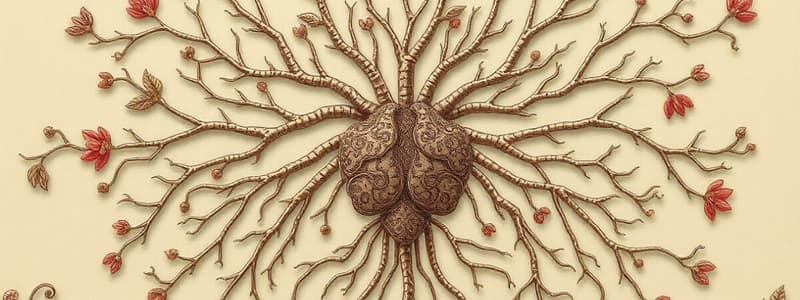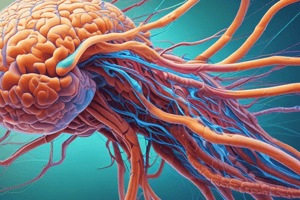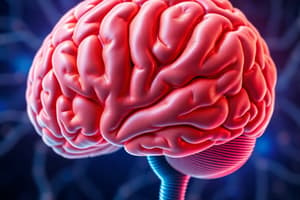Podcast
Questions and Answers
What is the primary function of nervous tissue as described?
What is the primary function of nervous tissue as described?
- Hormone production
- Regulating blood pressure
- Communication and body regulation (correct)
- Nutrient absorption
Which part of the nervous system is responsible for processing impulses?
Which part of the nervous system is responsible for processing impulses?
- Neuroglial cells
- Central Nervous System (correct)
- Cerebellum only
- Peripheral Nervous System
Which of the following structures is NOT part of the Central Nervous System?
Which of the following structures is NOT part of the Central Nervous System?
- Cerebellum
- Nerves (correct)
- Cerebrum
- Spinal Cord
What role do neuroglial cells play in the nervous system?
What role do neuroglial cells play in the nervous system?
Which of the following is NOT a function of the nervous system mentioned?
Which of the following is NOT a function of the nervous system mentioned?
How do neurons process impulses according to the information provided?
How do neurons process impulses according to the information provided?
Which characteristic distinguishes neurons from most other cell types in the body?
Which characteristic distinguishes neurons from most other cell types in the body?
Which of the following is a key factor in the feedback process of the nervous system?
Which of the following is a key factor in the feedback process of the nervous system?
What characterizes the outer molecular layer of gray matter?
What characterizes the outer molecular layer of gray matter?
Which of the following statements about white matter is true?
Which of the following statements about white matter is true?
What is the primary function of the central canal in the spinal cord?
What is the primary function of the central canal in the spinal cord?
What distinguishes the spinal cord compared to other components of the central nervous system?
What distinguishes the spinal cord compared to other components of the central nervous system?
Which layer of gray matter contains pyramidal cells that increase in size toward the inner granular layer?
Which layer of gray matter contains pyramidal cells that increase in size toward the inner granular layer?
Which component is NOT considered a part of the peripheral nervous system?
Which component is NOT considered a part of the peripheral nervous system?
What type of tissue surrounds and organizes axons in the peripheral nervous system?
What type of tissue surrounds and organizes axons in the peripheral nervous system?
What results from the lumbal puncture procedure?
What results from the lumbal puncture procedure?
What is the role of endoneurium in nerve axons?
What is the role of endoneurium in nerve axons?
Which statement correctly distinguishes myelinated from unmyelinated fibers?
Which statement correctly distinguishes myelinated from unmyelinated fibers?
What is the significance of the blood-brain barrier?
What is the significance of the blood-brain barrier?
What is the primary function of ganglia within the nervous system?
What is the primary function of ganglia within the nervous system?
Which of the following is NOT a type of ganglia mentioned in the content?
Which of the following is NOT a type of ganglia mentioned in the content?
Which condition is associated with damage to the myelin sheath?
Which condition is associated with damage to the myelin sheath?
What does the process of myelination impact during the growth and development of a neuron?
What does the process of myelination impact during the growth and development of a neuron?
What type of cells form the internodal segments in myelinated neurons?
What type of cells form the internodal segments in myelinated neurons?
What is the main role of dendrites in neurons?
What is the main role of dendrites in neurons?
Which type of synapse is most common between axons and dendrites?
Which type of synapse is most common between axons and dendrites?
What primarily determines the integrity of the axonal transport system?
What primarily determines the integrity of the axonal transport system?
Which neurotransmitter is identified as the most common in neuronal communication?
Which neurotransmitter is identified as the most common in neuronal communication?
Which type of transportation moves substances away from the nerve cell body?
Which type of transportation moves substances away from the nerve cell body?
What happens to the axon distal to the injury site in a neuron?
What happens to the axon distal to the injury site in a neuron?
What structure is important for synaptic communication between neurons?
What structure is important for synaptic communication between neurons?
Neuroglia can be found in which part of the nervous system?
Neuroglia can be found in which part of the nervous system?
What is the primary function of ependymal cells in relation to CSF production?
What is the primary function of ependymal cells in relation to CSF production?
Which part of the central nervous system is primarily associated with the continuous capillary structure?
Which part of the central nervous system is primarily associated with the continuous capillary structure?
What happens to the axon distal to an injury according to the content?
What happens to the axon distal to an injury according to the content?
Which statements correctly describe the characteristics of the blood-brain barrier?
Which statements correctly describe the characteristics of the blood-brain barrier?
What is the main effect of macrophages at the site of a nerve injury?
What is the main effect of macrophages at the site of a nerve injury?
What describes chromatolysis in the context of nerve injury?
What describes chromatolysis in the context of nerve injury?
What aspect of the blood-brain barrier is primarily responsible for protecting neurons from harmful substances?
What aspect of the blood-brain barrier is primarily responsible for protecting neurons from harmful substances?
Which component in the choroid plexus is responsible for the production of cerebrospinal fluid?
Which component in the choroid plexus is responsible for the production of cerebrospinal fluid?
Study Notes
Nervous System Overview
- Composed of two main parts: Central Nervous System (CNS) and Peripheral Nervous System (PNS).
- Fundamental network for communication and regulation in the body.
- Essential for human behavior, survival activities like eating, reproduction, and defense.
Types of Nervous Tissue
- Primary Cells: Neurons, which are responsible for signal transmission.
- Neurons cannot divide; they perform functions such as receiving impulses and integrating signals.
- Supporting Cells: Neuroglial cells, provide support and protection for neurons.
Central Nervous System (CNS)
- Divided into significant components:
- Cerebrum: Responsible for higher brain functions, including thought and action.
- Cerebellum: Regulates coordination and balance.
- Spinal Cord: Conducts signals between the brain and the rest of the body.
Peripheral Nervous System (PNS)
- Consists of nerve fibers outside the CNS:
- Encased in connective tissue for protection and organization.
- Composed of axons, ganglia, and nerve endings.
White and Gray Matter
- Grey Matter: Contains neuronal cell bodies and synapses; crucial for processing information.
- White Matter: Contains myelinated axons, facilitating rapid signal transmission; found beneath the cortex in the brain.
Neuron Structure
- Neurons have multiple processes, including dendrites for receiving stimuli.
- Key types of synapses:
- Axosomatic: Between axon and cell body.
- Axodendritic: Between axon and dendrites.
- Axoaxonic: Between two axons.
Neurotransmission
- Neurons communicate via synapses using neurotransmitters such as:
- Acetylcholine (most common)
- Amino acids (e.g., Glutamate)
- Monoamines (e.g., serotonin)
- Neuropeptides.
Axonal Transport
- Microtubules in neurons support axonal transport.
- Transport Types:
- Anterograde: Towards axon terminals.
- Retrograde: Towards the neuron cell body.
Myelination and Nerve Fibers
- Myelination occurs during growth and development; disruptions can cause conditions like multiple sclerosis.
- Two types of nerve fibers:
- Myelinated: Faster impulse transmission due to the myelin sheath and Nodes of Ranvier.
- Unmyelinated: Slower transmission, still associated with Schwann cells but without multiple layers.
Ganglia
- Composed of neuron cell bodies located outside the CNS.
- Types of ganglia:
- Sensory Ganglia: Relay sensory information.
- Autonomic Ganglia: Involved in involuntary motor functions (divided into sympathetic and parasympathetic).
Blood-Brain Barrier (BBB)
- Specialized capillaries in the CNS protect neurons from harmful substances while allowing essential nutrients to pass.
- Composed of continuous capillaries with tight junctions, preventing protein passage but allowing ion movement.
Choroid Plexus and Cerebrospinal Fluid (CSF)
- Choroid plexus generates CSF, which circulates in the brain's ventricles and subarachnoid space.
- CSF production and drainage must be balanced to maintain homeostasis.
Nervous System Injuries
- Injuries lead to potential axoplasmic leakage and shrinkage of proximal axons to minimize loss.
- Distal axons are at risk of degeneration, while Schwann cells can assist in repair processes post-injury.
Studying That Suits You
Use AI to generate personalized quizzes and flashcards to suit your learning preferences.
Related Documents
Description
Explore the components and functions of the nervous system, focusing on the Central and Peripheral Nervous Systems. Understand the roles of neurons and neuroglial cells in communication and regulation. This quiz covers fundamental concepts essential for grasping human behavior and biological activities.




